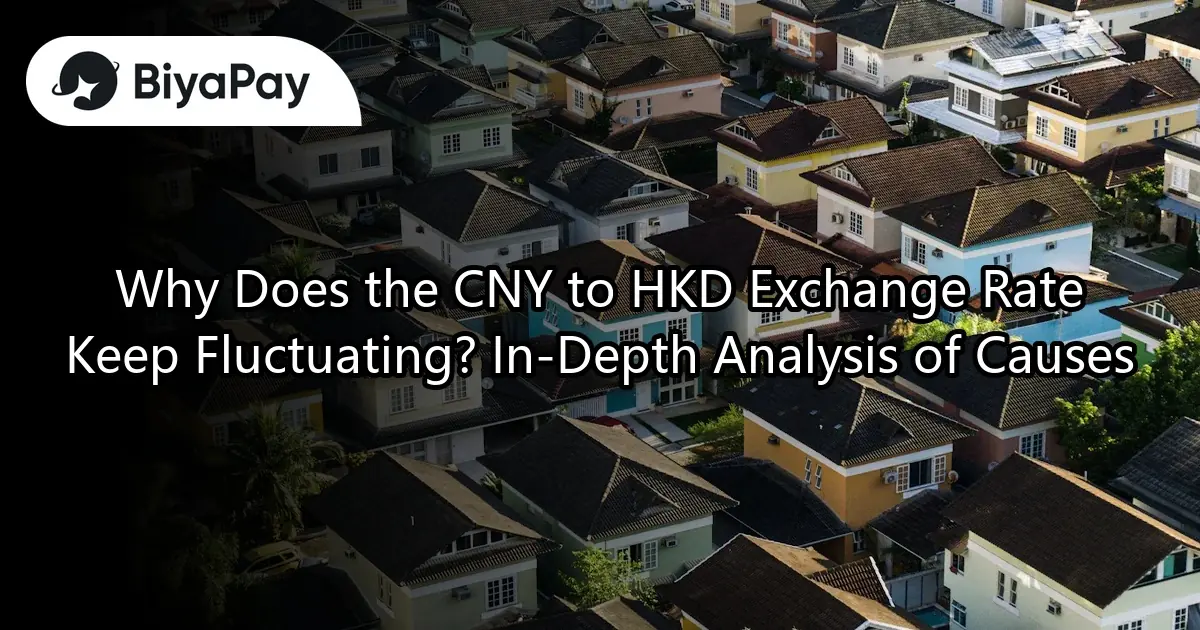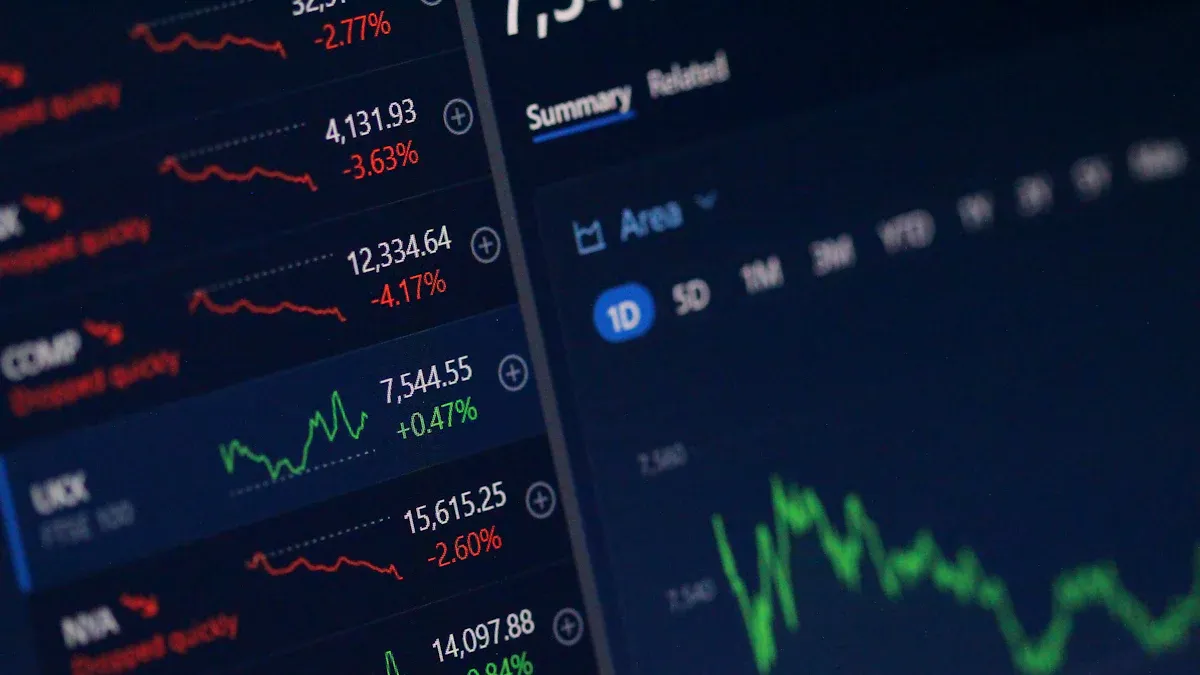- EasyCard
- Trade
- Help
- Announcement
- Academy
- SWIFT Code
- Iban Number
- Referral
- Customer Service
- Blog
- Creator
Why Does the CNY to HKD Exchange Rate Keep Fluctuating? In-Depth Analysis of Causes

Image Source: pexels
The CNY to HKD exchange rate has recently shown short-term stability, but over the past year, it has experienced significant volatility. The exchange rate has fluctuated between 1.0337 and 1.1105, reflecting differing market expectations for the economic outlook of China and Hong Kong. Professional observations indicate that external environments and policy adjustments continue to impact this exchange rate, with significant fluctuations likely in the future.
Key Points
- The fluctuation of the CNY to HKD exchange rate is primarily influenced by differing monetary policies between China and Hong Kong, changes in U.S. interest rates, and international capital flows.
- Hong Kong’s linked exchange rate system stabilizes the HKD, but rising U.S. interest rates can trigger capital flows, indirectly affecting the CNY to HKD exchange rate.
- Changes in the economic fundamentals of China and Hong Kong, including consumption, investment, and foreign capital flows, directly impact exchange rate trends and market confidence.
- International short-term capital flows far exceed trade demands, becoming the main driver of exchange rate fluctuations, requiring investors to closely monitor global capital dynamics.
- Investors and businesses should adopt diversified asset allocation and hedging strategies to flexibly address the risks and opportunities brought by exchange rate fluctuations.
Main Causes of Fluctuations
The CNY to HKD exchange rate is influenced by multiple factors, primarily including differences in monetary policies between China and Hong Kong, the U.S.-China interest rate differential, USD trends, economic fundamentals, and international capital flows. According to the latest market data, the CNY to HKD exchange rate has shown limited volatility over the past week, but significant fluctuations have occurred within the past 52 weeks, indicating short-term stability but potential for long-term volatility.
Monetary Policy
China and Hong Kong adopt different monetary policies. The People’s Bank of China implements a managed floating exchange rate system, adjusting interest rates and money supply based on economic conditions. Hong Kong, since 1983, has implemented a linked exchange rate system, pegging the HKD to the USD within a range of 7.75 to 7.85. This system requires Hong Kong banks to hold equivalent USD reserves when issuing HKD. When China adjusts its monetary policy to address economic pressures, the CNY to HKD exchange rate is directly affected. The Hong Kong Monetary Authority intervenes based on market conditions, such as in early May 2024, when it sold HKD and bought USD multiple times to stabilize the HKD exchange rate, effectively reducing market volatility.
Interest Rates and the USD
Changes in U.S. interest rates have a profound impact on the CNY to HKD exchange rate. When the U.S. raises interest rates, making USD rates higher than HKD rates, international capital engages in carry trades, flowing toward USD assets, putting pressure on both HKD and CNY. Liquidity in Hong Kong’s banking system changes due to capital flows, further affecting HKD demand. In the first quarter of 2023, the average daily turnover of Hong Kong stocks reached $242.7 billion, a year-on-year increase of 84%, with IPOs and dividend peaks boosting HKD demand. While the linked exchange rate system ensures HKD stability, changes in U.S. interest rates still influence capital flows through interest rate differentials, thereby affecting the CNY to HKD exchange rate.
Economic Fundamentals
Changes in the economic fundamentals of China and Hong Kong directly influence the CNY to HKD exchange rate. When China’s economic growth slows, the CNY’s competitiveness relative to the HKD declines. In recent years, the number of Chinese tourists visiting Hong Kong has not returned to pre-pandemic levels, reflecting China’s economic weakness and a reduced HKD exchange rate advantage. Hong Kong’s local economy has also been impacted by social movements and the pandemic, with service trade volume decreasing by approximately $581.3 billion from 2018 to 2020, leaving only 60% of its original level. The number of foreign enterprises has decreased, particularly from the U.S. and U.K., with Chinese enterprises accounting for 24.1% of companies in Hong Kong in 2023. U.S.-China geopolitical tensions and slowed capital market activity further impact Hong Kong’s regional competitiveness and HKD stability. Experts note that China’s officially reported GDP growth and unemployment data may not reflect actual economic conditions, with economic downturns leading to weakened consumption, investment, and export momentum, insufficient domestic demand, and foreign capital outflows, all of which affect the CNY to HKD exchange rate trend.
Tip: Economic fundamentals include not only GDP and unemployment rates but also consumption, investment, and foreign capital flows, which must be considered to comprehensively assess exchange rate trends.
International Capital Flows
International capital flows have become the primary driver of CNY to HKD exchange rate fluctuations. According to central bank data, global daily trade volumes in 2022 accounted for only 12.3% of spot foreign exchange transactions, with financial transactions comprising up to 96.6% when including derivatives. This shows that after capital liberalization, short-term capital flows have a far greater impact on exchange rates than trade itself. Taking Taiwan as an example, in 2024, foreign and domestic capital flows relative to goods trade were 19.3 times higher, reflecting the significant impact of short-term cross-border capital flows on exchange rates. In May 2024, the CNY to USD exchange rate fluctuated between 7.19 and 7.31, influenced by U.S. economic data and tariff expectations. The Hong Kong Monetary Authority intervened multiple times to stabilize the HKD exchange rate. International scholars generally believe that exchange rate adjustments have limited effectiveness in addressing current account imbalances and require coordination with savings, investment, and fiscal policy adjustments. Global current account imbalances cannot rely solely on exchange rate adjustments but also require improvements in economic structures.
- Financial transactions account for 96.6% of global foreign exchange transactions, making capital movements the primary cause of exchange rate fluctuations.
- Current account imbalances reflect structural economic issues, which cannot be resolved solely through exchange rate adjustments.
- The active financing in Hong Kong’s stock exchange IPO market boosts capital market demand for HKD, further influencing exchange rate fluctuations.
Historical Trends of the CNY to HKD Exchange Rate

Image Source: unsplash
Recent Volatility
In recent years, the CNY to HKD exchange rate has generally remained between 1.0 and 1.1. According to mainstream financial platforms, the exchange rate fluctuated between 1.0337 and 1.1105 over the past year. Based on 360-day volatility calculations, the CNY to HKD exchange rate volatility ranged from approximately 4.16% to 8.48%, with a distribution range covering 7.40% to 14.85%. The highest volatility reached up to 15%. These data reflect that while the exchange rate is generally stable, significant fluctuations can occur during specific periods. Investors should closely monitor market changes, especially when international capital flows intensify, as exchange rate volatility may widen.
Key Moments
Over the past few years, the CNY to HKD exchange rate has experienced several significant fluctuations. The “8.11 Exchange Reform” in 2015 brought severe market shocks. At that time, the exchange rate depreciated by approximately 8.9%, with the exchange rate index dropping from 6.6594, and daily trading volume reaching $543.2 billion. Before and after the reform, trading volume increased by 36%, with the exchange rate index fluctuating from 1.47 to 1.73, rising to 2.82 by June 2016, a 33% increase.
| Indicator | Value and Trend Description |
|---|---|
| Exchange Rate Depreciation | Approximately 8.9% |
| Exchange Rate Index | Approximately 6.6594, declining after the reform |
| Trading Volume | Reached $543.2 billion on the reform day |
| Exchange Rate Volatility | Approximately 8% |
| Trading Volume Increase | 36% (from $49 billion to $109 billion) |
| Exchange Rate Index Change | 1.47 to 1.73, reaching 2.82 in June 2016 |
On May 6, 2019, the offshore CNY to USD exchange rate fell sharply by 1.3%, dropping to 6.82, reflecting escalating U.S.-China trade tensions. From April to May 2024, the offshore CNY to USD exchange rate appreciated by nearly 2.7% from a low of 7.4, with the HKD exchange rate briefly rising to 7.75 in early May, prompting large-scale intervention by the Hong Kong Monetary Authority to maintain the stability of the linked exchange rate system.
Tip: To check real-time and historical exchange rate trends, you can refer to mainstream platforms like Wise, Yahoo Finance, and Investing.com for accurate data.
Future Trends
2025 Expectations
The market continues to focus on the CNY to HKD exchange rate trends for 2025. According to the latest market data, the CNY to USD spot exchange rate briefly rose to 7.1824 by the end of 2024, hitting a seven-month high. This appreciation was primarily driven by U.S. inflation being lower than expected, rising expectations of Federal Reserve rate cuts, and USD weakness. The market also observed a “de-dollarization” trend, boosting short-term CNY strength. However, AllianceBernstein’s Q1 2025 Global Economic Outlook notes that while China’s economy stabilized by the end of 2024, the effects of stimulus policies are gradually weakening, requiring stronger measures to drive growth in the future. The report highlights that the exchange rate may serve as an adjustment tool, similar to the over 5% CNY depreciation during the 2018 trade conflict to offset external shocks.
Multiple financial institutions predict that the USD to CNY exchange rate may break through 7.4 in the second half of 2024, potentially rising further in 2025. Influencing factors include the People’s Bank of China’s monetary policy, GDP, PMI, CPI, and other economic indicators, as well as USD trends. U.S. benchmark interest rates are expected to be around 4% by the end of 2024, and if the European Central Bank cuts rates earlier, the USD may weaken, putting pressure on the CNY to HKD exchange rate.
Experts suggest that investors closely monitor China’s economic data and Federal Reserve policy developments, flexibly adjusting asset allocations.
Potential Risks
Future fluctuations in the CNY to HKD exchange rate still face multiple risks. While U.S. inflationary pressure has temporarily stabilized, core CPI remains above the 2% target, with sticky prices in services and housing rentals increasing exchange rate uncertainty. Changes in U.S.-China trade policies, global economic growth slowdowns, and interest rate adjustments in major economies may exacerbate exchange rate volatility.
Experts note that the USD index rose 6.8% throughout 2024 due to rising U.S. bond yields, with expectations of continued strength in 2025. Geopolitical risks, such as the Russia-Ukraine war, pressures in China’s real estate market, and economic slowdowns in emerging markets, also pose potential black swan events.
Businesses and investors increasingly rely on big data and artificial intelligence technologies to enhance risk prediction and management capabilities. Global multi-data integration helps detect early warning signals, reducing losses from exchange rate fluctuations.
| Main Risk Sources | Impact Description |
|---|---|
| U.S. Inflation and Interest Rate Policy | Affects USD trends and capital flows |
| China’s Economic Data Fluctuations | Impacts CNY policy and market confidence |
| Geopolitical and Trade Conflicts | Increases market uncertainty |
| Global Economic Growth Slowdown | Affects exports, capital flows, and exchange rate stability |
Investors should continuously track global economic data and policy changes, using technological tools to enhance risk management capabilities and flexibly address future CNY to HKD exchange rate fluctuations.
Practical Impacts

Image Source: pexels
Individual Investors
Exchange rate fluctuations pose significant challenges for individual investors. When exchange rates between CNY, HKD, and USD change, the net asset value of investment portfolios fluctuates accordingly. Experts suggest that investors adopt diversified asset allocations to reduce risks from a single market or currency.
- Investors can consider allocating to composite bonds, high-rated bonds, and income-generating assets, while maintaining a certain cash position to enhance asset flexibility.
- Adopting exchange rate hedging strategies, such as purchasing forex hedging funds or using forward contracts, can help reduce the impact of exchange rate fluctuations on portfolios. However, hedging transactions incur settlement costs, which investors need to bear proportionally.
- A long-term investment perspective helps reduce interference from short-term news, and investors should thoroughly read fund prospectuses to understand exchange rate, credit, and interest rate risks, adjusting portfolios based on their risk tolerance.
- Recent multi-asset income strategies have recorded 2.1% positive returns year-to-date, with MAI strategies achieving a stable yield of 5.1%. Financial institutions recommend reducing global equity holdings, increasing income-generating assets and covered call options, and moderately overweighting gold to diversify risks.
Tip: Investors should avoid over-chasing short-term news and return to fundamentals, using multi-asset allocation and risk management strategies to address exchange rate fluctuations.
Corporate Responses
Businesses facing exchange rate fluctuations need to adopt diverse strategies to maintain financial stability. According to market reports, exchange rate fluctuations directly impact corporate financial performance and trade decisions. Fund management companies conduct exchange rate hedging transactions, which can reduce risks but also incur settlement costs, and not all risks can be fully eliminated.
Corporate financial reports and strategic analyses show the following measures to be effective:
- Natural hedging strategies: Companies use USD-denominated orders and procurement to offset each other, reducing the impact of exchange rate fluctuations on profits.
- Forward forex hedging tools: Complement natural hedging to further mitigate profit volatility.
- Global diversified production bases: Establishing factories in Southeast Asia, Mexico, and other regions to diversify production bases and leverage tariff agreements to reduce exchange rate and tariff risks.
- Adjusting product portfolios and pricing strategies: Modifying quotes based on exchange rate changes to control impacts within a short-term range.
- Deep collaboration with global brand giants: Producing and investing near customer markets and innovating products to enhance negotiation power and market stickiness.
- Investing in automated production lines: For example, TSMC’s investment in automated production lines in the U.S. reduces costs and enhances competitiveness.
These strategies have proven effective in corporate financial reports and market performance, enabling Taiwan’s electronics industry to maintain resilience and growth momentum under the dual pressures of exchange rates and tariffs. Businesses should continuously track market information, flexibly adjust financial and operational strategies, and enhance risk resilience.
The fluctuation of the CNY to HKD exchange rate primarily stems from the interplay of monetary policies, economic fundamentals, and international capital flows. Experts suggest that investors and businesses closely monitor market dynamics and regularly review asset allocations. Flexibly using hedging tools and diversified strategies can help mitigate potential risks. Maintaining information sensitivity enables timely adjustments to financial and investment decisions.
FAQ
How to check the CNY to HKD exchange rate?
Investors can check real Latina and historical exchange rates through mainstream platforms like Wise, Yahoo Finance, and Investing.com, with data based on USD for easy comparison.
Will exchange rate fluctuations affect Hong Kong bank deposits?
Hong Kong bank HKD deposits are protected by the linked exchange rate system. CNY to HKD exchange rate fluctuations mainly affect cross-border wealth management and foreign currency asset values, with limited impact on local HKD deposits.
How can businesses manage exchange rate risks?
Businesses can adopt forward contracts, natural hedging, and diversified production base strategies to reduce the impact of USD and CNY to HKD exchange rate fluctuations on finances.
What advice is there for individual investors regarding exchange rate fluctuations?
Experts recommend diversified asset allocation, appropriately allocating USD, HKD, and CNY assets, and using forex hedging tools to reduce losses from exchange rate fluctuations.
What are the predictions for the CNY to HKD exchange rate in 2025?
The market expects the USD to CNY exchange rate to potentially rise to 7.5, putting pressure on the CNY to HKD exchange rate. Investors should closely monitor economic data and policy developments in China and the U.S.
The CNY/HKD exchange rate, fluctuating between 4.16%-8.48% over the past year due to monetary policies, US interest rates, and global capital flows, poses challenges for investing in Hong Kong and US market growth enterprises—how can you optimize cross-border wealth management in volatile conditions? BiyaPay offers an all-in-one financial platform, enabling seamless trading of Hong Kong’s financial and tech sectors and US tech leaders without offshore accounts, empowering you to navigate exchange rate volatility with agility.
Supporting USD, HKD, and 30+ fiat and digital currencies, real-time exchange rate tracking ensures cost transparency, while global remittances to 190+ countries feature transfer fees as low as 0.5%, significantly below the 7.45% average traditional bank costs, with swift delivery to meet global investment needs. A 5.48% annualized yield savings product, with no lock-in period, balances exchange rate risks with steady returns. Sign up for BiyaPay today to integrate exchange rate hedging strategies with BiyaPay’s worldwide financial solutions, creating a secure, adaptable wealth management experience!
*This article is provided for general information purposes and does not constitute legal, tax or other professional advice from BiyaPay or its subsidiaries and its affiliates, and it is not intended as a substitute for obtaining advice from a financial advisor or any other professional.
We make no representations, warranties or warranties, express or implied, as to the accuracy, completeness or timeliness of the contents of this publication.




Contact Us
Company and Team
BiyaPay Products
Customer Services
is a broker-dealer registered with the U.S. Securities and Exchange Commission (SEC) (No.: 802-127417), member of the Financial Industry Regulatory Authority (FINRA) (CRD: 325027), member of the Securities Investor Protection Corporation (SIPC), and regulated by FINRA and SEC.
registered with the US Financial Crimes Enforcement Network (FinCEN), as a Money Services Business (MSB), registration number: 31000218637349, and regulated by FinCEN.
registered as Financial Service Provider (FSP number: FSP1007221) in New Zealand, and is a member of the Financial Dispute Resolution Scheme, a New Zealand independent dispute resolution service provider.



















